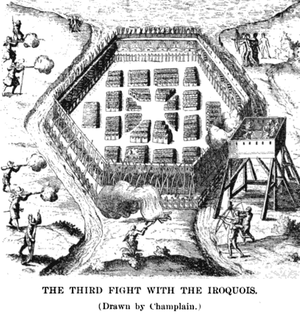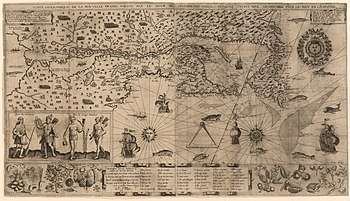Battle of Sorel
The Battle of Sorel occurred on June 19, 1610, with Samuel de Champlain supported by the Kingdom of France and his allies, the Wyandot people, Algonquin people and Innu people that fought against the Mohawk people in New France at present day Sorel-Tracy, Quebec.[1] The forces of Champlain armed with the arquebus engaged and killed or captured nearly all of the Mohawks.[1] The battle ended major hostilities with the Mohawks for twenty years.[1]
| Battle of Sorel | |||||||
|---|---|---|---|---|---|---|---|
| Part of the Beaver Wars | |||||||
 | |||||||
| |||||||
| Belligerents | |||||||
|
Huron Algonquin Innu |
| ||||||
| Commanders and leaders | |||||||
| Samuel de Champlain | unknown | ||||||
| Strength | |||||||
|
~500 warriors 5 arquebusiers |
~100 warriors 1 fort | ||||||
| Casualties and losses | |||||||
|
3 killed 50 wounded |
85 killed 15 captured 1 fort captured | ||||||
 Map of New France, by Samuel de Champlain, circa 1612 | |||||||
The Battle of Sorel was part of the Beaver Wars, which pitted the nations of the Iroquois confederation, led by the dominant Mohawks, against the Algonquian peoples of the Great Lakes region, supported by the Kingdom of France.[2] The Beaver Wars continued intermittently for nearly a century, ending with the Great Peace of Montreal in 1701.[3][4][5][6][7]
Origin
Before 1603, Champlain had formed an offensive alliance against the Iroquois, and a precedent was set that the French would not trade firearms to the Iroquois. He had a commercial rationale: the northern Natives provided the French with valuable furs and the Iroquois, based in present-day New York State, interfered with that trade.
The transition from a seasonal coastal trade into a permanent interior fur trade was formally marked with the foundation of Quebec City on the St. Lawrence River in 1608 by Samuel de Champlain. This settlement marked the beginning of the westward movement of French traders from the first permanent settlement of Tadoussac at the mouth of the Saguenay River on the Gulf of St. Lawrence, up the St. Lawrence River and into the Pays d'en Haut around the Great Lakes. What followed in the first half of the 17th century were strategic moves by both the French and the indigenous groups to further their own economic and geopolitical ambitions.
The first deliberate battle in 1609 was fought at Champlain's initiative. Champlain deliberately went along with a war party down Lake Champlain. Furthermore, this battle created 150 years of mistrust that poisoned any chances that French-Iroquois alliances would be durable and long lived. De Champlain wrote, "I had come with no other intention than to make war".[8][9] In the company of his Huron[8] and Algonkin[8] allies, Champlain and his forces fought a pitched battle with the Mohawk[8] on the shores of Lake Champlain. Champlain singlehandedly[8] killed three Iroquois chiefs with an arquebus despite the war chiefs having worn "arrowproof body armor made of plaited sticks".[8]
Aftermath
During the 1600s the Kingdom of France realizing the ongoing conflicts, established a military of New France consisting of a mix of regular soldiers of the French Army, French Navy and Canadien volunteer militia units. The French built many Forts including Fort Richelieu, established at the mouth of the Richelieu River, near Sorel, in 1641. The fort was built by Charles Huault de Montmagny, first Governor and Lieutenant-Governor of New France and named in honour of Cardinal Richelieu, chief minister to Louis XIII. Fort Richelieu was burned down by the Iroquois in 1647 then rebuilt in 1665 by the Carignan-Salières Regiment, under the direction of Pierre de Saurel.
The French and Indian Wars continued with a series of intermittent conflicts between the years 1688 to 1763 as follows: King William's War (1688–1697); Queen Anne's War (1702–1713); King George's War (1744–1748); and the French and Indian War (1754–1763).[10]

The Treaty of Paris (1763) was signed on 10 February 1763 by the kingdoms of Great Britain, France and Spain, with Portugal in agreement, after Britain's victory over France and Spain during the Seven Years' War. The signing of the treaty formally ended the French and Indian Wars[11] and marked the beginning of an era of British dominance outside Europe.[12] The two nations returned much of the territory that they had each captured during the war, but Britain gained much of France's possessions in North America. The treaty did not involve Prussia and the Habsburg Monarchy (Austria) as they signed a separate agreement, the Treaty of Hubertusburg, five days later.
See also
Further reading
- Barr, Daniel. (2006). Unconquered: The Iroquois League at War in Colonial America. Santa Barbara: Praeger Publishers; 1st edition. ISBN 978-0275984663
- Hackett Fischer, David. (2008). Champlains Dream. New York City: Simon & Schuster; 1st edition. ISBN 978-1416593324
- Jaenen, Cornelius. (1996). The French Regime in the Upper Country of Canada During the Seventeenth Century. Toronto: Champlain Society; 1st edition. ISBN 978-0969342571
References
- Fischer, David Hackett (2008). Champlain's Dream. Random House of Canada. pp. 577–578. ISBN 978-0-307-39767-6.
- Barr, Daniel P. (2006). Unconquered: The Iroquois League at War in Colonial America. Greenwood Publishing Group. ISBN 0-275-98466-4.
- Raaflaub, Kurt A. (2007). War and peace in the ancient world. Wiley-Blackwell. p. 359. ISBN 978-1-4051-4526-8.
- Harris, Richard Cole; Matthews, Geoffrey J. (1993). Historical Atlas of Canada. University of Toronto Press. p. 82. ISBN 978-0-8020-2495-4.
- Tucker, Spencer C.; Arnold, James; Wiener, Roberta (2011). The Encyclopedia of North American Indian Wars, 1607–1890: A Political, Social, and Military History. ABC-CLIO. p. 12. ISBN 978-1-85109-697-8.
- Cox, Bruce Alden (1987). Native People, Native Lands: Canadian Indians, Inuit and Métis. McGill-Queen's University Press. p. 7. ISBN 978-0-88629-062-7.
- Brandão, José António (2000). Your Fyre Shall Burn No More: Iroquois Policy Toward New France and Its Native Allies to 1701. University of Nebraska Press. p. 100. ISBN 978-0-8032-6177-8.
- Brandon, William (1964). The American Heritage Book of Indians. Dell. p. 187. ISBN 978-0-440-30113-4.
- Jennings, p. 42
- Leckie, Robert (1999). A Few Acres of Snow: The Saga of the French and Indian Wars. Wiley & Son. ISBN 0-471-24690-5.
- Marston, Daniel (2002). The French–Indian War 1754–1760. Osprey Publishing. pp. 84. ISBN 0-415-96838-0.
- "Wars and Battles: Treaty of Paris (1763)". United States History. Retrieved 19 October 2019.
In a nutshell, Britain emerged as the world's leading colonial empire.